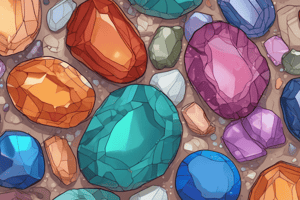Podcast
Questions and Answers
Which type of Chrysoberyl is characterized by a 'milk and honey' effect?
Which type of Chrysoberyl is characterized by a 'milk and honey' effect?
- Chiastolite
- Andalusite
- Cat's Eye (correct)
- Alexandrite
What are the primary sources of Alexandrite?
What are the primary sources of Alexandrite?
- Sri Lanka and Brazil (correct)
- Ural Mountains of Russia and Brazil
- Myanmar's Mogok Stone Tract and East Africa
- India
Which type of Chrysoberyl is known for its 'emerald by day, ruby by night' characteristic?
Which type of Chrysoberyl is known for its 'emerald by day, ruby by night' characteristic?
- Alexandrite (correct)
- Chiastolite
- Andalusite
- Cat's Eye
What is the typical carat weight range for Cat's Eye Chrysoberyl?
What is the typical carat weight range for Cat's Eye Chrysoberyl?
Which type of Chrysoberyl is often used to create synthetic tanzanite?
Which type of Chrysoberyl is often used to create synthetic tanzanite?
Where is the best quality Andalusite found?
Where is the best quality Andalusite found?
What is the name of the synthetic process used to create green Chrysoberyl?
What is the name of the synthetic process used to create green Chrysoberyl?
Which company was the first to produce a commercially available synthetic cat's-eye color-change alexandrite?
Which company was the first to produce a commercially available synthetic cat's-eye color-change alexandrite?
What is the typical cut used for Cat's Eye Chrysoberyl?
What is the typical cut used for Cat's Eye Chrysoberyl?
Which type of Chrysoberyl is known for its fine quality and even proportions?
Which type of Chrysoberyl is known for its fine quality and even proportions?
What is the name of the Chrysoberyl variety that exhibits a chatoyant band?
What is the name of the Chrysoberyl variety that exhibits a chatoyant band?
What is the name of the Chrysoberyl variety that is formally known as 'chrysolite'?
What is the name of the Chrysoberyl variety that is formally known as 'chrysolite'?
Which of the following Chrysoberyl varieties is known for its strong color change or 'Alexandrite Effect'?
Which of the following Chrysoberyl varieties is known for its strong color change or 'Alexandrite Effect'?
What is the name of the Chrysoberyl variety that is characterized by a semitransparent, golden yellow to slightly greenish yellow color?
What is the name of the Chrysoberyl variety that is characterized by a semitransparent, golden yellow to slightly greenish yellow color?
Which of the following Chrysoberyl varieties is colored by traces of vanadium?
Which of the following Chrysoberyl varieties is colored by traces of vanadium?
What is the name of the Chrysoberyl variety that is characterized by a transparent, greenish yellow color with no chatoyancy?
What is the name of the Chrysoberyl variety that is characterized by a transparent, greenish yellow color with no chatoyancy?
Which of the following Chrysoberyl varieties is known for its pleochroic colors?
Which of the following Chrysoberyl varieties is known for its pleochroic colors?
What is the name of the Chrysoberyl variety that is characterized by a strong, bluish green to yellowish green color in daylight?
What is the name of the Chrysoberyl variety that is characterized by a strong, bluish green to yellowish green color in daylight?
Which of the following Chrysoberyl varieties is formally known as 'Cymophane'?
Which of the following Chrysoberyl varieties is formally known as 'Cymophane'?
What is the name of the Chrysoberyl variety that is characterized by a green, non-phenomenal color?
What is the name of the Chrysoberyl variety that is characterized by a green, non-phenomenal color?
In which country is Iolite primarily found?
In which country is Iolite primarily found?
What is the typical size range for Iolite?
What is the typical size range for Iolite?
In which regions of Africa is Iolite found?
In which regions of Africa is Iolite found?
In which country is Iolite also found, apart from Sri Lanka?
In which country is Iolite also found, apart from Sri Lanka?
What is the notable effect exhibited by Iolite?
What is the notable effect exhibited by Iolite?
Is Iolite known for its phenominal or non-phenominal properties?
Is Iolite known for its phenominal or non-phenominal properties?
What is the MOHS scale of Iolite?
What is the MOHS scale of Iolite?
What is the chemical composition of Iolite?
What is the chemical composition of Iolite?
What is the typical source of Iolite?
What is the typical source of Iolite?
What phenomenon is exhibited by Iolite?
What phenomenon is exhibited by Iolite?
What is the typical cut used for Iolite?
What is the typical cut used for Iolite?
What is the typical color range of Iolite?
What is the typical color range of Iolite?
What is the hardness of Iolite compared to Tanzanite?
What is the hardness of Iolite compared to Tanzanite?
Is Iolite ever treated?
Is Iolite ever treated?
What is the typical clarity of Iolite?
What is the typical clarity of Iolite?
What is the typical color range of Andalusite?
What is the typical color range of Andalusite?
What is the chemical composition of Andalusite?
What is the chemical composition of Andalusite?
What is the notable phenomenon exhibited by Andalusite?
What is the notable phenomenon exhibited by Andalusite?
What is a unique characteristic of the Chiastolite type of Andalusite?
What is a unique characteristic of the Chiastolite type of Andalusite?
What is the typical clarity of Chiastolite?
What is the typical clarity of Chiastolite?
What is the hardness of Andalusite on the MOHS scale?
What is the hardness of Andalusite on the MOHS scale?
What is the typical cut used for Chiastolite ?
What is the typical cut used for Chiastolite ?
Which of the following countries is known for producing Andalusite with the best hues?
Which of the following countries is known for producing Andalusite with the best hues?
What is the range of sizes for Andalusite?
What is the range of sizes for Andalusite?
Which of the following is a characteristic of Andalusite?
Which of the following is a characteristic of Andalusite?
In which of the following countries is Andalusite also found, apart from Brazil?
In which of the following countries is Andalusite also found, apart from Brazil?
What is the typical bodycolor of Andalusite?
What is the typical bodycolor of Andalusite?
Flashcards are hidden until you start studying
Study Notes
Gemstone Types and Characteristics
- Alexandrite: rare, faceted mixed cut, exhibits color change, also known as "emerald by day, ruby by night"
- Cat's Eye: cabochon with inclusions, fine quality has girdle-to-girdle inclusions, typically 0.50 to 2.00 cts.
- Andalusite: faceted, sizes range from 1 to 10 cts., also known as Chiastolite
- Tanzanite: variety of zoisite, typically faceted, fine quality is pure blue or intense violet-blue
- Iolite: also known as Cordierite, transparent, violetish blue through violet hue, pleochroic colors range from light/dark violet to yellow/yellow-brown and blue gray
Origins and Sources
- Tanzanite: Merelani in northern Africa, near Tanzania
- Iolite: Sri Lanka, several areas of Africa, Kenya, central Tanzania, and the island of Madagascar, India, Brazil, Norway, and Finland
- Alexandrite: Ural Mountains of Russia, Sir Lanka, Brazil, India, Myanmar's Mogok Stone Tract, East Africa, and Madagascar
- Cat's Eye: Sir Lanka, Brazil, Myanmar's Mogok Stone Tract, Zimbabwe, Madagascar, and Tanzania
- Andalusite: Brazil, Sri Lanka, and Spain
Synthetic Processes
- Tanzanite: synthetic forsterite is used as synthetic tanzanite due to its pleochroic qualities
- Alexandrite: produced using "Czochralski", floating zone, and flux methods
- Green Chrysoberyl: vanadium is used to produce bluish green, nonphenomenal, pulled synthetic chrysoberyl
Physical Properties
- Tanzanite: Mohs scale 6 to 7
- Iolite: Mohs scale 7 to 7.5
- Alexandrite: Mohs scale 8.5
- Andalusite: Mohs scale 7 to 7.5
Phenomena and Characteristics
- Tanzanite: exhibits pleochroism
- Iolite: exhibits pleochroism
- Alexandrite: exhibits color change or "the alexandrite effect" and cat's eye
- Cat's Eye: exhibits chatoyancy and pleochroism
- Andalusite: exhibits pleochroic colors, also hues of olive or brownish green, yellowish green, and brownish red
Tanzanite
- Named and promoted by Tiffany's in 1968
- Found in Merelani, northern Africa, near Tanzania
- Variety of zoisite
- Fine quality is pure blue, intense violet-blue, or violet body color
- Has a Mohs scale hardness of 6 to 7
- Often heat-treated to enhance color
Iolite
- Also known as cordierite
- Found in Sri Lanka, Africa, India, Brazil, Norway, and Finland
- Transparent, violetish blue to violet hue
- Has a Mohs scale hardness of 7 to 7.5
- Often found in alluvial deposits
Alexandrite
- Variety of chrysoberyl
- Found in Ural Mountains of Russia, Sri Lanka, Brazil, India, Myanmar, and East Africa
- Has a strong color change effect, appearing bluish green in daylight and orangy red in incandescent light
- Has a Mohs scale hardness of 8.5
- Often found in alluvial deposits
Cat's Eye Chrysoberyl
- Type of chrysoberyl with a distinct, straight, silver-white chatoyant band
- Found in Sri Lanka, Brazil, Myanmar, and Zimbabwe
- Fine quality is semitransparent with a golden yellow to slightly greenish yellow or brownish yellow color
- Often cut into a cabochon shape
Andalusite
- Found in Brazil, Sri Lanka, and Spain
- Has a Mohs scale hardness of 7 to 7.5
- Can appear in various colors, including brownish or yellowish green, orange, pink, or violet
- Often found in alluvial deposits
General Information
- Pleochroism is a phenomenon where a gemstone appears to change color when viewed from different angles
- The "Alexandrite Effect" is a specific type of color change phenomenon
- Chatoyancy is a phenomenon where a gemstone appears to have a moving band of light
- Many gemstones are treated or synthetic to enhance their appearance or color
Tanzanite
- Named and promoted by Tiffany's in 1968
- Government control of the mine affects prices
- TV promoted it to US consumers
- Variety of zoisite
- Mohs scale: 6 to 7
- Fine quality is pure blue, intense violet-blue, or strong purplish pleochroic
- Can be heat-treated to turn brown stone to blue and violet
Iolite
- Also known as "Cordierite"
- Transparent, violetish blue to violet hue
- Pleochroic colors range from light to dark violet and yellow to yellow-brown
- Mohs scale: 7 to 7.5
- Found in alluvial deposits
- Cleavage in one direction makes it vulnerable when mounted
Alexandrite
- Variety of chrysoberyl
- Mohs scale: 8.5
- Very strongly bluish green to yellowish green in daylight, and orangy red to purplish red in incandescent light
- Exhibits the "Alexandrite Effect"
- Found in alluvial deposits
- Mainly faceted, always cut to show best color change
Cat's Eye Chrysoberyl
- Chrysoberyl with a distinct, straight, silver-white chatoyant band
- Fine quality is semitransparent, golden yellow to slightly greenish yellow, or brownish yellow
- Can be pleochroic
- Typically 0.50 to 2.00 cts.
Andalusite
- Aluminum silicate
- Mohs scale: 7 to 7.5
- Can be brownish or yellowish green to orangy brown, pure green, brown, pink, or violet
- Finest quality is yellowish green and orange
- Can be pleochroic, with colors tending towards reds, greens, and oranges
- Found in Spain, Brazil, and Sri Lanka
General Information
- Largest consumers of these gemstones are not specified
- Chemical composition: Tanzanite (silica, calcium, aluminum), Iolite (silicate of aluminum, iron, and magnesium), Alexandrite (beryllium aluminum oxide), Andalusite (aluminum silicate)
- Forming sources: Iolite (alluvial deposits), Alexandrite (alluvial deposits), Andalusite (trace elements of iron and titanium)
- Possible phenomena: Tanzanite (pleochroism), Iolite (pleochroism), Alexandrite (color change), Cat's Eye (chatoyancy), Andalusite (pleochroism)
Studying That Suits You
Use AI to generate personalized quizzes and flashcards to suit your learning preferences.




